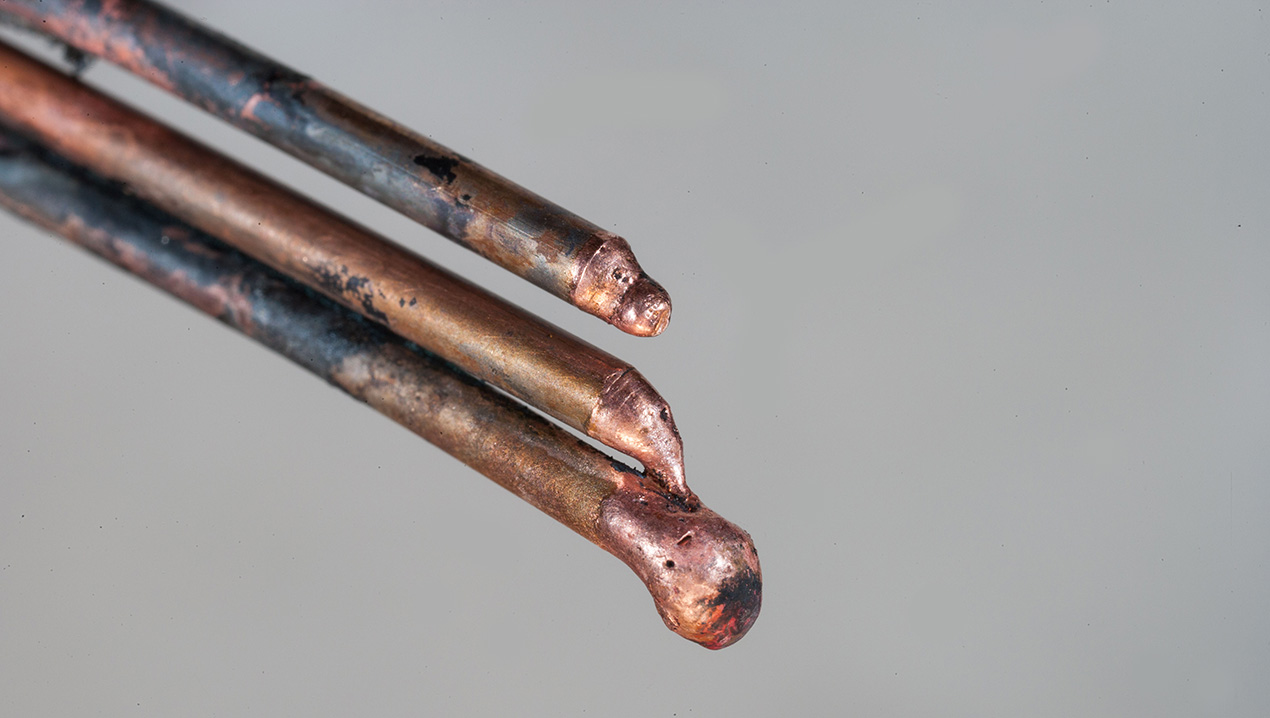EXPERIMENTS TO PRODUCE ARC BEADS IN COPPER WIRES
The cable is the most common for branch circuits in residential construction, often referred to as “Romex.” It is NEC Type NM-B, 12 AWG solid, two conductor with ground, connected in the ordinary way to single-phase, 120 VAC power via a 20-amp modular circuit breaker. This cable was subjected to direct contact with the outer flame mantle from a natural-gas fired Bunsen burner in a laboratory fume hood.
Electrical data was sampled at 200 kHz with a Hioki 8842 equipped with 8936 analog input modules. This unit is a combination data logger and oscilloscope which records multiple channels simultaneously. Voltages from hot to ground, and neutral to ground, and current through all three conductors were recorded. The current was measured as the voltage drop across a measured length of the NM-B conductor whose resistance was 0.01 ohms. Real power was computed by simple multiplication of instantaneous voltage times current. No averaging or smoothing was done. Instantaneous power of around 30 kW was typical during arcing.
Video was recorded with a Sanyo VPC-FH1A camcorder at 60 frames per second in 1080P HD. The lens was augmented by a 3M Speedglas 9002X auto-darkening filter, normally used as eye protection during arc welding, which has a darkening switching time of less than 150 microseconds which is less than 1% of the inter-frame period. This amounts to a very fast autoexposure function which affords a visible image of both arcing and non-arcing events.
Arc beads are the result of a process known as "arcing through char", in which the PVC sheath on electrical conductors degrades due to exposure to fire or fire temperatures. Polymers such as PVC break down into "char", which is the carbonaceous product remaining after heat exposure. Char provides a conductive path for electricity, thereby producing an electric field in which the temperature exceeds the boiling point of copper. Thus, the wire is severed by the arc.
Arcing resulted in metal loss from expulsion of molten copper during the arc duration.
A divot was formed from localized melting then transfer of molten metal.
One wired severed completely, producing ends of different shapes due to metal loss.
The bottom wire exhibits two very different shaped ends due to metal loss.
The sharp demaracation between bead and wire is evident here on the neutral and ground wires.
Arcing between the ground and hot wires produced a divot from metal transfer.
These are scanning electron microscopic images of the wire with the divot broken open. The higher magnification view at right shows a fracture surface consisting of voids interlaced with dimples from ductile rupture.
Arc beads can take many shapes. They always, however, show a sharp demarcation between the bead and the cylindrical wire.
Arc bead shapes are determined by gravity, cooling rate and immediate surroundings.
The microstructures of arc beads exhibit sharp demarcations between the bead and the cylindrical wire, numerous voids of various sizes within the bead, a recrystallized grain structure in the wire, and a dendritic structure in the bead.
The arc shape is determined by gravity, among other factors such as immediate surroundings and solidification rate.








